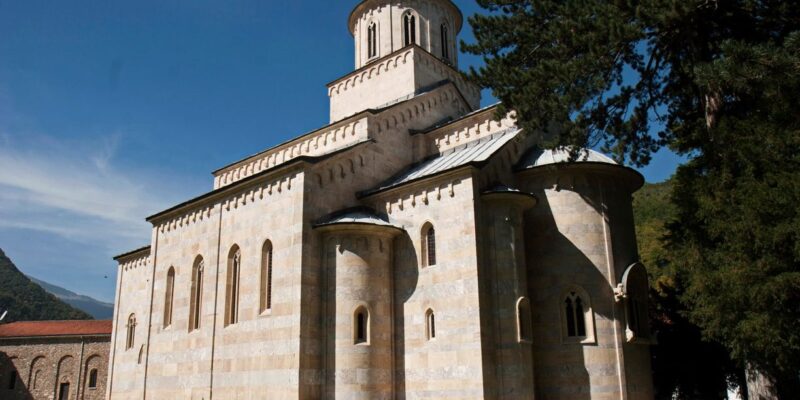WHOSE ARE THE CULTURAL AND HISTORICAL MONUMENTS IN KOSOVO AND METOHIJA?
On May 7, 2025 | 0 Komentari
Veselin P. Dzeletovic
When discussing the cultural and historical heritage of a region, it’s important to ask: who lived there, what did they build, and what remains as lasting testimony of the times? Kosovo and Metohija are territories where civilizations have intertwined, but historical traces bear witness to a dominant culture and identity. This text attempts to answer a simple question: Whose cultural and historical monuments are in Kosovo and Metohija?
Let’s proceed step by step…
What is a cultural and historical monument?
A cultural and historical monument is a structure or site that holds exceptional historical, cultural, artistic, scientific, or social value, representing a testimony of a particular time, people, or civilization. Such a monument can be:
-
an architectural structure (e.g., church, fortress, bridge),
-
an artwork (fresco, sculpture),
-
an archaeological site,
-
or even an entire urban or rural entity (e.g., old town).
For something to be recognized as a cultural and historical monument, it must meet some of the following criteria:
-
Authenticity – preserved in its original form or convincingly reconstructed.
-
Historical value – bears witness to a significant event, person, culture, or period.
-
Artistic or architectural value – represents a prominent example of style, technique, or artistic expression.
-
Continuity and tradition – has been in use or veneration across generations.
Serbian Presence – Kosovo and Metohija Defined by Sacred Sites
Kosovo and Metohija were the core of medieval Serbian statehood. It was precisely in this region that the most significant spiritual, cultural, and administrative centers of the medieval Serbian state were established. The World Heritage Committee inscribed Visoki Dečani on the UNESCO World Heritage List as part of the “Medieval Monuments in Kosovo.” This imperial lavra was joined by the Patriarchate of Peć, Gračanica, and Our Lady of Ljeviš.
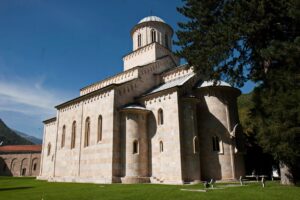
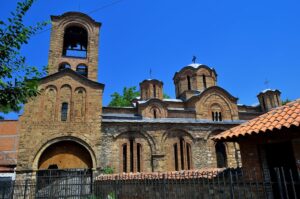
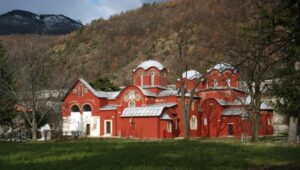
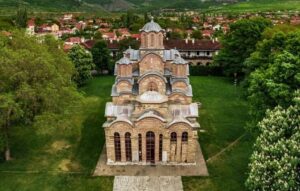
These Serbian sanctuaries have also been placed on the list of endangered world heritage. This inevitably raises the question: from whom and what are they endangered? The list of endangered Serbian sanctuaries in Kosovo and Metohija does not include the multitude of churches and monasteries, church sites, cemeteries, excavations… which are under constant attack by Albanian terrorists.
For every church and monastery in Kosovo and Metohija, there are credible records, data, and charters about who built them and when. And whose endowments they are. There are also numerous adelphates confirming this.
Albanian Presence – Without Cultural and Historical Traces
The Albanian population began settling in larger numbers in Kosovo and Metohija only in the 17th century, as a consequence of Turkish wars, migrations, and the emigration of Serbs. During that period, demographic changes occurred, but not the creation of cultural infrastructure in the form of monuments that would testify to earlier Albanian historical presence in this area.
Based on available data, archaeological findings, historical documents, and state registers:
-
there is not a single cultural and historical monument in Kosovo and Metohija built by the Albanian population before the 19th century.
-
there is not a single church, fortress, school, or monastery of Albanian origin that would testify to early, independent cultural or state presence of Albanians in that area.
Monuments sometimes cited as “Albanian” (such as towers – defensive houses of tribal families) mostly date from the 19th century and represent ethnological, but not cultural and historical monuments in the classical sense. These structures are not cultural and historical monuments in the classical sense: they lack artistic value, liturgical function, or historical continuity over time. In the absence of their own structures, to prove historical continuity in that area (which doesn’t exist), there is an attempt to appropriate Ottoman and Serbian cultural assets.
Attempt to Seize Serbian Sanctuaries
History must not be turned into a weapon. It is heritage. And heritage belongs not only to us but to the entire world that wishes to call itself civilized. In times when history is increasingly reshaped to suit daily political needs, it’s important to return to facts and truth. Kosovo and Metohija, a region deeply rooted in Serbian spiritual and state identity, is increasingly being presented as exclusively Albanian, with even the most renowned Serbian monasteries, such as Visoki Dečani, being claimed as “Albanian heritage.”
This is not only inaccurate – but also culturally dangerous. Every such attempt at appropriation must be adequately addressed. The global public must be informed of the truth about this. As well as the fact of how many Serbian sanctuaries were destroyed in the pogroms against Serbs. And to clearly and loudly state that they were destroyed by those who now claim them. Europe – which rightfully takes pride in its cathedrals, castles, and cultural treasures – is silently watching as in the territory of Kosovo and Metohija: centuries-old monasteries and churches are being appropriated, cultural roots are being falsified, monks and priests are being threatened, and Serbian presence is being reduced to a “relic” meant to quietly disappear.
Was that the price of peace for Europe? If so – they have achieved peace without justice. And peace without justice is not peace, but a silent defeat of someone’s morality. When the history of a people is erased, and cultural heritage destroyed — and all this happens before the eyes of a silent world — then that silence becomes complicity.
Is there a greater shame than watching the disappearance of what UNESCO called “world heritage” — and remaining silent?
Who Built and Whose Are the Most Significant Mosques in Kosovo and Metohija?
1. Sinan Pasha Mosque (Prizren), Built: 1615, Patron: Sinan Pasha, Grand Vizier of the Ottoman Empire, Note: This is one of the largest and most imposing mosques in the region. Located in the old core of Prizren, it is also known for being built, according to some sources, using materials from the demolished Monastery of the Holy Archangels.
2. Imaret Mosque (Sultan Murad Mosque, Pristina), Built: 1389/1392 (according to tradition, immediately after the Battle of Kosovo), Patron: Sultan Murad I (or his son Bayezid I), Note: Located near the türbe (tomb) of Sultan Murad, it represents one of the oldest Islamic religious buildings in the region.
3. Mosque in Peć (Bajrakli Mosque / Fatih Mosque), Built: 15th century, Patron: Mehmed II the Conqueror (Sultan Mehmed Fatih), Note: Considered one of the first mosques built after the Ottoman conquest of these areas.
4. Mosque in Đakovica (Haji Shefvan Mosque), Built: late 16th century, Patron: Haji Shefvan
5. Mosque in Vučitrn, Built: 15th century, Patron: A family from the Ottoman administration (exact patron unknown), Note: Vučitrn was an important administrative center, and the pasha’s residence was located there, along with the mosque.
These Ottoman structures meet the criteria of continuity and tradition of cultural-historical monuments, but they are not Albanian!
Conclusion
The history of Kosovo and Metohija is deeply Serbian in terms of its cultural heritage. Historically, there is not a single Albanian cultural-historical monument in this region before the 19th century. This is not a political message – but a historical fact confirmed by archaeologists, historians, and institutions such as UNESCO and the Republic Institute for the Protection of Cultural Monuments.
Modern reality cannot be built on the denial of the past. The truth does not belong to either side – but to those willing to speak it. Historical facts are not subject to voting, but to research and responsibility. If one seeks the truth, it must be stated clearly: there are no Albanian historical monuments in Kosovo and Metohija. This does not mean Albanians are not part of the contemporary reality of the area, but it does mean that their cultural heritage cannot be projected into a past that it does not belong to.
The truth is not against anyone – it is a prerequisite for reconciliation and a just understanding of the times in which we live.
Sources:
-
-
-
Republic Institute for the Protection of Cultural Monuments of Serbia – Register of Cultural Goods in Kosovo and Metohija
-
SANU: “Kosovo and Metohija in Serbian History”, SANU Collection of Papers
-
Dušan Bataković (ed.) – The Kosovo Chronicles
-
Vojislav Đurić – History of Serbian Art
-
Alexander Deroko – Medieval Monasteries in Serbia, Montenegro and Macedonia
-
Milutin Garašanin – Archaeological studies on the continuity of Christian heritage.







